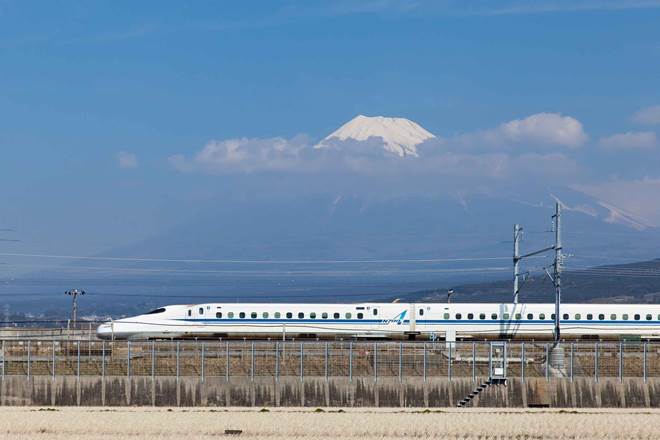Say konnichiwa to Japan with a super flexible and affordable way to travel: Japanese rail passes.
Traveling Japan by train is part of the visitor experience. With bullet trains hitting top speeds of 320 km/h — that’s a brisk 200 mph, folks — navigating Japan via public transport is quick and convenient. Over 8,500 railway stations connect the country (Tokyo has nearly 900, alone) which include a few of the busiest train stations in the World. Main train stations include:
- Tokyo Train Station
- Nagoya Train Station
- Kyoto Train Station
- Hiroshima Train Station
- Osaka Train Station
- Fukuoka Train Station
Best of all, you can use a Japan Rail Pass (also commonly called the JR Pass) and Green Japan Rail Pass on hundreds of routes, including Shinkansen bullet trains, express trains, rapid/local trains, BRT, the Tokyo Monorail, and much more.

What rail pass should I buy in Japan?
The Japan Rail Pass was created for non-Japanese passport holders, similar to how the Eurail Pass was created for non-Europeans. This Japan Rail Pass for tourists is ideal for:
- Widespread travel throughout Japan
- Visitors spending between 7 and 21 days in the country
- Riding (almost) all Shinkansen bullet train routes in Japan
You have two options: a traditional Japan Rail Pass and the Green JR Pass.
Ordinary Japan Rail Pass vs Green Pass
The regular Japan Rail Pass and the Green Japan Rail Pass both include unlimited travel throughout Japan, free seat reservations, free Wifi, and rides along the high speed Shinkansen bullet train routes in Japan.
The Green Japan Rail Pass is a premium first-class pass that expands upon the Japan Rail Pass by also offering:
- Separate First Class seating carriages
- Comfortable, extra wide seats
- More luggage space
- More privacy
- Free amenities on certain trains including drinks, candy, and Oshibori hand towels
What is not covered by the JR Pass?
The Japan Rail Pass offers extreme flexibility and freedom, but you can’t hop on just any train you see. Look for the train stations and train lines that have the JR logo and you’re in the clear.
For example, Mizuho and Nozomi Shinkansen services are not included unless you pay a supplement. Subways, metros, and underground lines are not covered by the Japan Rail Pass — but the Tokyo monorail is.
How much does the Japan Rail Pass cost?
Prices for the Japan Rail Pass range between US$330 and US$923 depending on seat class and number of days you’re traveling.
|
Adult JR Pass* |
Adult Green Pass* | |
|
7 Days |
¥50,000 (approx. £259/$336) |
¥70,000 (approx. £363/$470) |
|
14 Days |
¥80,000 (approx. £415/$538) |
¥110,000 (approx. £570/$739) |
|
21 Days |
¥100,000 (approx. £518/$672) |
¥140,000 (approx. £726/$941) |
* The currency exchange rate provided is from 12Go's website and is valid as of 21st March 2025. Exchange rates fluctuate and may vary at the time of transaction. Fully up-to-date prices can be found on the 12Go website.
Is it cheaper to buy a JR Pass or individual tickets?
If you’re traveling throughout Japan for more than five days, a JR pass is likely the cheaper option. Individual tickets and regional passes are usually a cheaper option when you’re sticking to one-to-two regions or the Tokyo-Kyoto-Osaka “golden triangle”. For instance, if you’re spending a week in Japan mostly in Tokyo but with one or two days in Kyoto/Osaka, individual tickets or a single regional pass might be a better bet.
What are the disadvantages of a Japan Rail Pass?
The biggest disadvantage of the Japan Rail Pass is that these physical passes must be redeemed in person. Similar to the old-school Eurail Passes, you’ll need to purchase your JR Pass in advance to ensure you receive the exchange order on time. You’ll then swap the exchange order for a physical JR Pass at a JR ticket office in Japan. Some travelers report being able to ship their JR Pass to their hotel in Japan for convenience.
🚆Trainline Tip: Regional passes do not need physical tickets; they use QR code e-tickets. These passes can be a more affordable way to travel, offering the same flexibility as the Japan Rail Pass, but ensuring that your budget is dedicated solely to the regions you want to travel.
Is a Japan Rail Pass worth it?
Yes, for most travelers, a Japan Rail Pass is worth it if you’re visiting the country for a week or more and want supreme access to Japan’s rail lines. Flexibility and affordability make a Japan Rail Pass worth it for most European and American visitors to Japan.
A Japan Rail Pass is not worth it if you’re only in the country for a long weekend, if you’re spending all of your time in one city, like Tokyo, or if you already know where to go in Japan and have a set itinerary in a single specific region.
How to purchase train tickets in Japan
Listen, you can purchase Japanese train tickets at the station. But let’s really think about that…
You’re in Japan — a place that once seemed so far away yet now, here you are, spending your days in a dream destination. What would you rather see: Shibuya Crossing? Mount Fuji?
Or a long train station ticket line?
Don’t follow the crowd, queueing up at each station to purchase single-route tickets. Purchase an affordable Japan Rail Pass with help from Trainline so you can explore the Land of the Rising Sun for as little yen, stress, and inconvenience as possible.
With Trainline’s partner, 12Go, you can buy a Japan Rail Pass online today. (By clicking the button below, you will be transferred to the website of 12Go, our official partner.)


